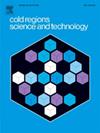Evolution characterization of moisture migration and pressure-melting of artificially frozen soft soil based on low-temperature triaxial seepage MRI system
IF 3.8
2区 工程技术
Q1 ENGINEERING, CIVIL
引用次数: 0
Abstract
The artificial ground freezing method has been increasingly applied in complex construction environments, including coastal seepage and ground stress environments. To investigate the water migration and pressure-melting characteristics of artificially frozen clay and sandy silt under seepage boundary conditions, a self-developed low-temperature triaxial multiphase seepage Magnetic Resonance Imaging (MRI) test system was used to analyze the seepage channel development, water migration and pore structure changes of soft soil under the coupling effects of freezing and seepage. Additionally, the evolution of ice during pressure melting and the pore size distribution of frozen soft soils were obtained. The results revealed that seepage action created non-uniform seepage channels in frozen clay, which were concentrated near the seepage outlet, while sandy silt formed more uniform seepage channels. Under the coupling effects of freezing and seepage, at −30 °C, the unfrozen water content inside the soil gradually decreased by 40 % and 94 %, respectively, compared to that at room temperature, and the sandy silt was almost completely frozen. The pressure melting facilitated the gradual conversion of ice into water and increased the unfrozen water content within the clay. Under the coupling effects of freezing and seepage, micropores were predominantly observed in both clay and sandy silt. The percentage of micropores in clay remained at 100 % under different pressures, demonstrating the high stability of the microporous structure under high-stress conditions. This study can promote the development of frozen soil testing technology and provides a scientific theoretical basis for infrastructure construction in artificial freezing projects.
基于低温三轴渗流MRI系统的人工冻结软土水分迁移与压力融化演化特征
人工冻结法在海岸渗流、地应力环境等复杂施工环境中的应用越来越广泛。为研究人工冻结粘土和砂质粉土在渗流边界条件下的水迁移和压力融化特性,采用自行研制的低温三轴多相渗流磁共振成像(MRI)测试系统,分析冻结与渗流耦合作用下软土的渗流通道发育、水迁移和孔隙结构变化。此外,还得到了冰在压力融化过程中的演变和冻结软土的孔隙大小分布。结果表明,渗流作用在冻结粘土中形成了不均匀的渗流通道,渗流通道集中在渗流出口附近,而砂质粉土形成了更均匀的渗流通道。在冻结和渗流的耦合作用下,在−30℃时,土中未冻水含量较室温分别逐渐减少40%和94%,砂质粉土几乎完全冻结。压力融化促进了冰逐渐转化为水,增加了粘土中未冻水的含量。在冻结和渗流耦合作用下,粘土和砂质粉土均以微孔为主。在不同压力下,粘土中微孔的比例均保持在100%,表明微孔结构在高应力条件下具有较高的稳定性。本研究可促进冻土检测技术的发展,为基础设施人工冻结工程建设提供科学的理论依据。
本文章由计算机程序翻译,如有差异,请以英文原文为准。
求助全文
约1分钟内获得全文
求助全文
来源期刊

Cold Regions Science and Technology
工程技术-地球科学综合
CiteScore
7.40
自引率
12.20%
发文量
209
审稿时长
4.9 months
期刊介绍:
Cold Regions Science and Technology is an international journal dealing with the science and technical problems of cold environments in both the polar regions and more temperate locations. It includes fundamental aspects of cryospheric sciences which have applications for cold regions problems as well as engineering topics which relate to the cryosphere.
Emphasis is given to applied science with broad coverage of the physical and mechanical aspects of ice (including glaciers and sea ice), snow and snow avalanches, ice-water systems, ice-bonded soils and permafrost.
Relevant aspects of Earth science, materials science, offshore and river ice engineering are also of primary interest. These include icing of ships and structures as well as trafficability in cold environments. Technological advances for cold regions in research, development, and engineering practice are relevant to the journal. Theoretical papers must include a detailed discussion of the potential application of the theory to address cold regions problems. The journal serves a wide range of specialists, providing a medium for interdisciplinary communication and a convenient source of reference.
 求助内容:
求助内容: 应助结果提醒方式:
应助结果提醒方式:


